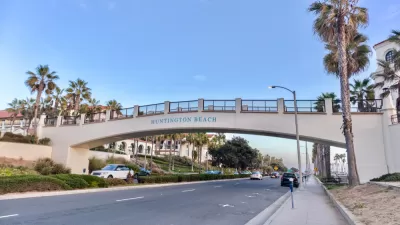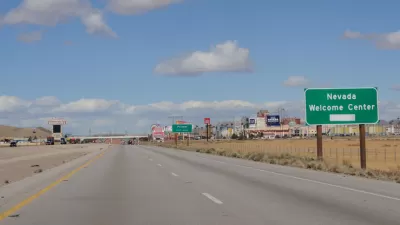A Berkeley parking lot is the site of the state's first implementation of a controversial landmark law that allows eligible developments with affordable housing to bypass the normal channels for approval if they conform to local zoning laws.
On March 8, a Berkeley developer proposing to develop a 2.2-acre parking lot adjacent to Berkeley's Capitol Corridor train station "filed an application with the City of Berkeley for streamlined approval of a 260‐unit multifamily project that will include 50% affordable housing," according to the press release [pdf] of West Berkeley Investors, a subsidiary of Danville, Calif.-based Blake Griggs Properties. In so doing, they became the first to enact SB-35, sometimes referred to as the state's "by-right" housing law.
The City of Berkeley established its rules – including General Plan and Zoning requirements—that designated this site for housing.
Meeting the current zoning, as well as the inclusion of affordable housing, are two of the main requirements for making developments eligible for the streamlined approval process, and perhaps making 1900 Fourth a test case to for the new law, closely followed by Planetizen last year, to see if works as intended.
We may know within 180 days – that's how long it takes for projects that comply with the law’s requirements to be guaranteed approval, "unheard of in a region where even straightforward housing developments can take three or four years," reports J.K. Dineen for the San Francisco Chronicle.
While all but 13 of the state's 482 cities and 58 counties fail to meet some parts of the state's regional housing needs allocation requirements, thus making them eligible for by-right housing, the percentage of affordable housing necessary in the development varies depending on the city. "In Berkeley — as well as in San Francisco and Oakland — a development must be at least 50 percent affordable to take advantage of the law," adds. Dineen.
The developer's attorney explains why the new law is needed in Berkeley, but the reasoning applies for most of coastal California where the housing shortage is greatest.
“Every infill location in Berkeley that is suitable for housing has passionate opponents – which is why Berkeley and the vast majority of other jurisdictions in the Bay Area have fallen far behind in approving enough housing that’s actually affordable to people who work here."
KPIX 5 (CBS SF Bay Area) reporter, Devin Fehely, reporting from the parking lot, interviews Lauren Seaver of West Berkeley Investors (see newscast).
"It’s been a very frustrating five years and millions of dollars of expense trying to bring affordable housing to this parking lot,” said Seaver.
Seaver is hopeful the new law will help her company cut through years of red tape and force the Berkeley City Council to finally greenlight a project that would build much-needed affordable housing.
“It has very straightforward criteria that says if the project fits the zoning for the location then the city is required to approve it,” adds Seaver.
The law's author, state Sen. Scott Wiener (D-San Francisco), released a statement on seeing the first implementation of the new law.
Expediting the production of housing at all income levels, including badly needed affordable housing, is exactly what SB 35 is about. This project was stalled for years, and now it will move forward with a large amount of affordable housing.
Affordable housing is a major beneficiary of SB 35, since the law streamlines affordable housing in almost every California community. SB 35 ensures that *all* communities add new housing. This goes to show that if we push the envelope on housing – which we did with SB 35 – good things will happen.”
Fehely acknowledges the claim by the Ohlone tribe that the parking lot contains artifacts, though "an archaeological dig found no evidence it had ever been home to a Native American shellmound," reported Berkeleyside via KQED in 2014.
Additional media coverage on the first implementation of SB 35 in California:
- Berkeleyside: "Developer invokes new state law to force Berkeley to approve 260-unit on Fourth Street," March 8
- The Mercury News: "Berkeley housing development first to seek fast-track under controversial new state law," March 8
FULL STORY: New Legislation Could Speed Planned Berkeley Development

Study: Maui’s Plan to Convert Vacation Rentals to Long-Term Housing Could Cause Nearly $1 Billion Economic Loss
The plan would reduce visitor accommodation by 25,% resulting in 1,900 jobs lost.

North Texas Transit Leaders Tout Benefits of TOD for Growing Region
At a summit focused on transit-oriented development, policymakers discussed how North Texas’ expanded light rail system can serve as a tool for economic growth.

Using Old Oil and Gas Wells for Green Energy Storage
Penn State researchers have found that repurposing abandoned oil and gas wells for geothermal-assisted compressed-air energy storage can boost efficiency, reduce environmental risks, and support clean energy and job transitions.

Private Donations Propel Early Restoration of Palisades Playground
Los Angeles has secured over $1.3 million in private funding to restore the Pacific Palisades playground months ahead of schedule, creating a modern, accessible space that supports community healing after recent wildfires.

From Blight to Benefit: Early Results From California’s Equitable Cleanup Program
The Equitable Community Revitalization Grant (ECRG) program is reshaping brownfield redevelopment by prioritizing projects in low-income and environmental justice communities, emphasizing equity, transparency, and community benefits.

Planting Relief: Tackling Las Vegas Heat One Tree at a Time
Nevada Plants, a Las Vegas-based nonprofit, is combating the city’s extreme urban heat by giving away trees to residents in underserved neighborhoods, promoting shade, sustainability, and community health.
Urban Design for Planners 1: Software Tools
This six-course series explores essential urban design concepts using open source software and equips planners with the tools they need to participate fully in the urban design process.
Planning for Universal Design
Learn the tools for implementing Universal Design in planning regulations.
Ascent Environmental
Borough of Carlisle
Institute for Housing and Urban Development Studies (IHS)
City of Grandview
Harvard GSD Executive Education
Toledo-Lucas County Plan Commissions
Salt Lake City
NYU Wagner Graduate School of Public Service





























